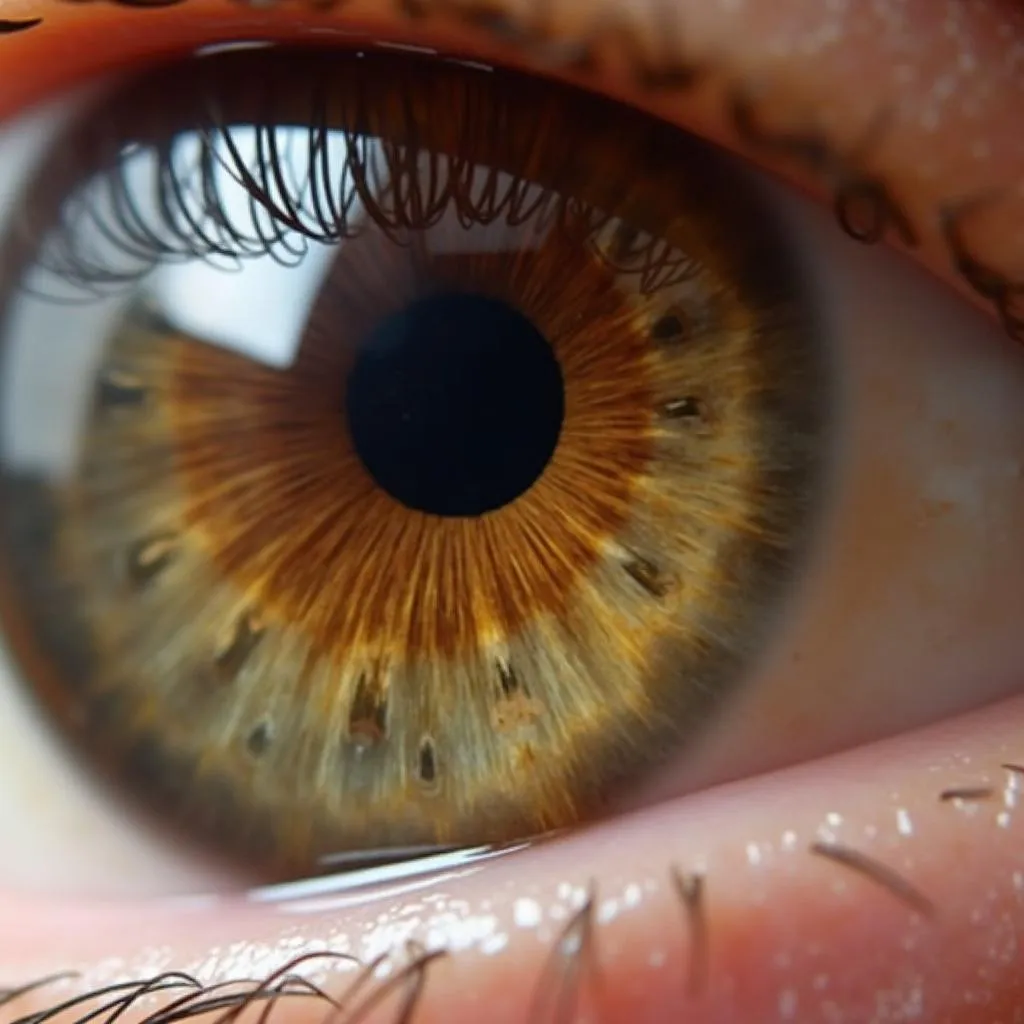Hazel eyes, a captivating blend of hues, often leave people wondering about their true nature. Are they brown? Are they green? Or maybe a bit of both? The answer, as with most things in nature, is beautifully complex.
 Hazel eye close-up
Hazel eye close-up
Decoding the Hazel: It’s All About Melanin and Light
The key to understanding hazel eyes lies in understanding melanin. Melanin is a pigment that determines the color of our eyes, skin, and hair. Higher melanin concentration results in darker colors, like brown eyes, while lower concentrations lead to lighter colors, like blue or green eyes.
Hazel eyes fall somewhere in the middle of this spectrum. They have more melanin than blue or green eyes but less than brown eyes. This unique balance creates a captivating interplay of colors, with shades of gold, brown, and green swirling together.
But that’s not all. The way light scatters within the iris, a phenomenon known as Rayleigh scattering, also plays a crucial role. This scattering effect enhances certain colors, making hazel eyes appear to shift and change depending on the lighting conditions.
The Spectrum of Hazel: Exploring the Different Shades
Just like no two snowflakes are alike, no two hazel eyes are exactly the same. The unique combination of melanin and light scattering leads to a beautiful variety of hazel shades. Some common variations include:
- Light Hazel: Often described as golden hazel, this variation leans towards a lighter, more amber hue.
- Medium Hazel: This shade typically features a balanced blend of green and brown, with hints of gold.
- Dark Hazel: Sometimes mistaken for light brown eyes, this variation has a deeper brown base with subtle green and gold flecks.
- Hazel Green: As the name suggests, this shade has a more prominent green presence, creating a mesmerizing blend of green and hazel.
 Woman with hazel-green eyes
Woman with hazel-green eyes
The Allure of Hazel: Why We Find Them So Captivating
Hazel eyes, with their ever-changing nature and unique blend of colors, have long been a source of fascination and admiration. Some attribute this allure to their relative rarity, as only about 5% of the world’s population has hazel eyes. Others believe it’s the inherent warmth and depth that these eyes seem to possess.
Whatever the reason, there’s no denying that hazel eyes hold a special kind of magic. They are a reminder that beauty often lies in the unexpected, in the subtle nuances that make each of us unique.
Beyond the Color: Other Factors that Influence Hazel Eyes’ Appearance
While melanin and light scattering are the primary determinants of hazel eye color, other factors can influence their appearance.
- Genetics: Like most physical traits, eye color is hereditary. If you have hazel eyes, chances are someone in your family tree also had them.
- Age: Believe it or not, our eye color can change slightly as we age. This is particularly true for babies, whose eye color may continue to develop until they are a few years old.
- Health and Mood: While not as dramatic as changes caused by genetics or age, our overall health and emotional state can subtly affect how our eyes appear, even leading to slight variations in color perception.
Hazel Eyes: A World of Wonder in Every Glance
From the science behind their captivating hues to the various shades that make them so unique, hazel eyes offer a fascinating glimpse into the complexities of human genetics and the beauty of natural variation. So the next time you lock eyes with someone sporting this mesmerizing eye color, take a moment to appreciate the interplay of nature’s artistry at work.
FAQ About Hazel Eyes
1. Can hazel eyes change color?
While hazel eyes don’t typically undergo drastic color changes like some other eye colors can, their appearance can shift subtly based on factors like lighting, clothing, and even mood.
2. What is the rarest hazel eye color?
Hazel eyes, in general, are relatively rare, but some variations, like amber hazel or hazel with central heterochromia (two different colors within the same iris), are considered even more uncommon.
3. What hair color looks best with hazel eyes?
Hazel eyes offer a lot of versatility when it comes to complementary hair colors. Warm browns, rich auburns, golden blondes, and even certain shades of red can all enhance the natural beauty of hazel eyes. how do i know what color to dye my hair
4. What makeup looks best with hazel eyes?
Neutral eyeshadows like browns, taupes, and bronzes can enhance the warmth of hazel eyes. For a bolder look, try jewel tones like emerald green, sapphire blue, or amethyst purple.
5. Are hazel eyes the same as amber eyes?
While both are often described as having a golden hue, amber eyes typically have a more solid, uniform color, while hazel eyes usually feature a blend of brown, green, and gold.
6. Do hazel eyes need more sun protection?
Like all eye colors, hazel eyes are susceptible to sun damage. It’s crucial to wear sunglasses that offer UV protection whenever you’re exposed to sunlight.
7. Can colored contacts change hazel eyes to brown?
Yes, colored contacts can temporarily change the appearance of hazel eyes to brown or any other desired color. what is the best colored contacts for brown eyes However, it’s essential to consult with an eye care professional to ensure you choose contacts that are safe and comfortable for your eyes.
Exploring the World of Eye Color
Still curious about the fascinating world of eye color? Delve deeper with these related articles:
- Can iris change color: Discover the factors that can influence eye color changes throughout life.
- What color are Tom Hanks eyes: Explore the eye color of this renowned actor and how it contributes to his on-screen presence.
For personalized advice on enhancing your own unique eye color or creating a captivating living space that reflects your individual style, don’t hesitate to reach out. Contact us at 0373298888, email [email protected], or visit our showroom at 86 Cầu Giấy, Hà Nội. Our team of color experts is available 24/7 to help you bring your vision to life.

